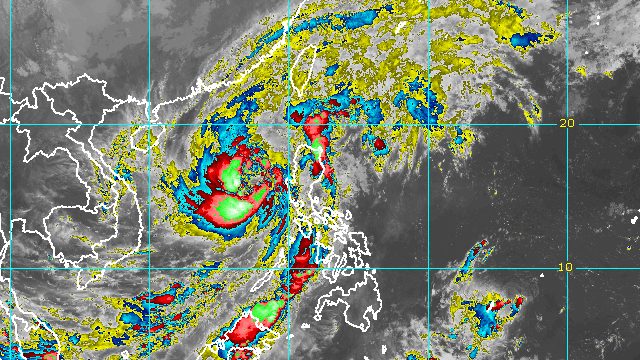SUMMARY
This is AI generated summarization, which may have errors. For context, always refer to the full article.

MANILA, Philippines – While Tropical Storm Paeng (Nalgae) is on its way out of the Philippine Area of Responsibility (PAR), some areas may still have rain until Monday morning, October 31.
In a bulletin released past 11 pm on Sunday, October 30, the Philippine Atmospheric, Geophysical, and Astronomical Services Administration (PAGASA) said Paeng was located 255 kilometers west of Iba, Zambales, over the West Philippine Sea.
The tropical storm’s movement shifted again, from west southwest to east southeast. It slowed down further as well, moving at only 10 kilometers per hour from the previous 20 km/h.
PAGASA said Paeng is likely to head north northwest or northwest from Sunday evening to Wednesday, November 2, before turning west northwest toward the southern part of China.
Its exit from PAR is now expected to happen on Monday afternoon or evening, instead of morning or afternoon.
Paeng continued to have maximum sustained winds of 85 km/h and gustiness of up to 105 km/h on Sunday evening.
It may re-intensify into a severe tropical storm in the next 12 hours, or by Monday morning, and become a typhoon on Tuesday, November 1, when it would already be outside PAR.
Paeng may start weakening late Tuesday, however, due to another surge of the northeast monsoon or hanging amihan.
The following areas may still experience rain from Paeng until Monday morning:
Moderate to heavy rain
- Zambales
- Bataan
- Pangasinan
- Batanes
- northern part of Cagayan including Babuyan Islands
Light to moderate rain, with at times heavy rain
- Cordillera Administrative Region
- Mimaropa
- rest of Cagayan Valley
- Tarlac
- Pampanga
- Cavite
- western part of Batangas
- Western Visayas
PAGASA said floods and landslides “are likely to slowly subside,” except in areas which saw significant rainfall the past days or those still hit by persistent heavy rain.
Strong winds may also continue in these areas, which remain under Signal No. 1 as of 11 pm on Sunday:
- part of Cagayan (Piat, Santo Niño, Camalaniugan, Tuao, Pamplona, Enrile, Alcala, Amulung, Baggao, Solana, Rizal, Claveria, Tuguegarao City, Gattaran, Peñablanca, Iguig, Lasam, Ballesteros, Abulug, Allacapan, Sanchez Mira, Santa Praxedes, Lal-lo)
- Isabela
- Quirino
- Nueva Vizcaya
- Apayao
- Abra
- Kalinga
- Mountain Province
- Ifugao
- Benguet
- Ilocos Norte
- Ilocos Sur
- La Union
- Pangasinan
- Aurora
- Bulacan
- Nueva Ecija
- Tarlac
- Pampanga
- Bataan
- Zambales
- Metro Manila
- western and central parts of Batangas (San Nicolas, Calaca, Cuenca, Lian, Tuy, Balayan, Talisay, Agoncillo, San Pascual, Santo Tomas, Bauan, San Jose, Calatagan, San Luis, Lemery, Lipa City, Ibaan, Tanauan City, Mabini, Mataasnakahoy, Alitagtag, Balete, Tingloy, Nasugbu, Batangas City, Laurel, Santa Teresita, Taal, Malvar)
- Cavite
- Laguna
- Rizal
- northwestern part of Oriental Mindoro (San Teodoro, Puerto Galera, Baco)
- northwestern part of Occidental Mindoro (Abra de Ilog, Mamburao, Paluan, Santa Cruz) including Lubang Islands
- northern part of Quezon (General Nakar, Infanta)

The gale warning issued at 5 pm on Sunday remains in effect, covering the following seaboards:
- western seaboards of Northern Luzon and Central Luzon (western coast of Ilocos Norte, Ilocos Sur, La Union, Pangasinan, Zambales, Bataan) – very rough to high seas, waves 4.5 to 7 meters high
- western seaboard of Southern Luzon, northern and eastern seaboards of Northern Luzon, eastern seaboard of Central Luzon (Batanes, Cagayan including Babuyan Islands, northern coast of Ilocos Norte, Isabela, Aurora, Pampanga, Bulacan, Metro Manila, Cavite, Batangas) – rough to very rough seas, waves 3.4 to 5.5 meters high
- eastern and southern seaboards of Southern Luzon, western seaboard of Visayas (Quezon including Polillo Islands, Occidental Mindoro including Lubang Islands, Oriental Mindoro, Marinduque, Romblon, southwestern coast of Camarines Sur, southwestern coast of Albay, southwestern coast of Sorsogon, Masbate including Burias Island and Ticao Island, Aklan, Antique, Capiz, Iloilo, Guimaras, Negros Occidental, Palawan including Calamian, Cuyo, Cagayancillo, and Kalayaan Islands) – rough to very rough seas, waves 3.1 to 5 meters high
“Rough to high sea conditions are risky for all types of sea vessels. Mariners are advised to remain in port or take shelter in port until winds and waves subside,” PAGASA said.
Paeng is the Philippines’ 16th tropical cyclone for 2022 and the fourth for October.
It made landfall five times, all as a severe tropical storm on Saturday, October 29:
- Virac, Catanduanes – 1:10 am
- Caramoan, Camarines Sur – 1:40 am
- Buenavista, Quezon – 6 am
- Santa Cruz, Marinduque – 8:40 am
- Sariaya, Quezon – 1:40 pm
After hitting Quezon for a second time, Paeng crossed Laguna, Cavite, the Metro Manila-Rizal-Bulacan area, Pampanga, and Zambales.
Even before its landfalls in Luzon, Paeng already wreaked havoc in parts of Mindanao and the Visayas. Over 40 people died in Maguindanao del Norte landslides and flooding.
Another tropical cyclone is expected to join Paeng inside PAR by Monday morning.
PAGASA said the tropical depression it has been monitoring was already 1,055 kilometers east of northeastern Mindanao on Sunday evening. It slightly accelerated, moving west southwest at 15 km/h from the previous 10 km/h.
It will be given the local name Queenie once it enters PAR. Inside PAR, it may head for the sea east of Caraga or Eastern Visayas, PAGASA said.
As of Sunday evening, the tropical depression still had maximum sustained winds of 45 km/h and gustiness of up to 55 km/h. It is likely to stay a tropical depression until Tuesday evening, then weaken into a low pressure area by Wednesday.
PAGASA said the tropical depression is unlikely to directly affect the Philippines until Tuesday. But it could trigger scattered rain showers and thunderstorms in the Eastern Visayas-Caraga area on Wednesday.

– Rappler.com
Add a comment
How does this make you feel?





There are no comments yet. Add your comment to start the conversation.